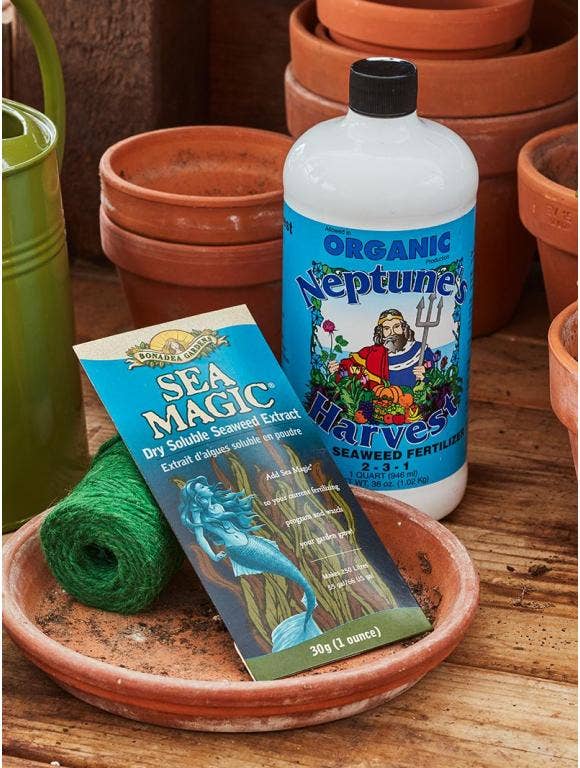
You nurtured seedlings all winter, transplanted them outdoors successfully and now, you're protecting them from pests, watering regularly and dutifully pulling weeds.
But there's one piece missing from your plant-care puzzle: fertilizer. When determining how to fertilize your vegetable garden, you'll need to develop a fertilizer calendar based on a variety of factors.
Not sure where to start? Here's exactly how to create a garden fertilizing schedule tailored to your plot's needs.
Vegetable Fertilizer Basics
Fertilizer can help boost your plants' bounty, but how does it work? In short, fertilizer replenishes and supplements soil with the nutrients your vegetables need to grow healthy roots, foliage and fruits.
Organic fertilizers consist of naturally occurring materials, while synthetic fertilizers contain manufactured materials. Synthetic fertilizers are available for plants to absorb more quickly because they're already in soluble form. Organic fertilizers, on the other hand, need soil bacteria and fungi to break them down into absorbable components. Synthetic fertilizers usually contain only three out of 17 essential elements for plants, whereas organic fertilizer usually contains all of them, says Burpee horticultural expert Brie Zettl. "This larger number of nutrients has been shown to result in better flavor and higher nutrient content," she adds.
The numbers on each bag of fertilizer represent the percentage of nitrogen, phosphorus and potassium, or N-P-K, within. For example, 10-10-10 means the fertilizer contains 10% of each element. This balanced mix supports overall plant health. Nitrogen promotes leafy growth, which is why lawn fertilizers typically contain a larger percentage. Potassium encourages strong root development, while phosphorous helps flower and fruit production.
How to Apply Vegetable Fertilizer
First, perform a soil test to determine whether your garden truly needs fertilizer (more on that below). If your soil is lacking nutrients, then fertilizer or compost can be cultivated into the top several inches of soil. Prior to planting, Zettl recommends taking a gentle approach. "Fertilizer can easily burn young plants, so I generally use organic matter, such as aged compost, to amend the soil before planting," she says.
Two to three weeks after planting, you can spread fertilizer around the soil just below the outer canopy of the plant. Do not put fertilizer near the stem, and remember to water after application, Zettl adds.
Before You Plant
Before you run to the garden center and fill your cart with fertilizer, take these crucial steps to set your garden up for success.
1. Perform a Soil Test
Send a soil sample to your local extension office for the most accurate, reliable results. It's virtually impossible to know how to fertilize your vegetable garden without first knowing your soil's pH and nutrient level. If you make an uneducated guess, you risk applying the wrong fertilizer, damaging your plants or spending money on products you don't need.
According to the University of New Hampshire Cooperative Extension, the optimal soil pH for vegetables falls between 6.5 and 6.8. Your test results should provide instructions on how to lower or raise your soil's pH, such as boosting pH levels with lime or lowering them with iron sulfate.
Before fertilizing, be sure you understand and adjust your soil's pH. Once your results fall in the vegetable pH sweet spot, you'll be ready to get fertilizing and planting.
Depending on where you live, your soil may already be garden-ready: "In some parts of the country — think soil enriched by volcanic eruptions in Washington state and Oregon, for example — potassium levels in the soil are already really high," Zettl says. "Phosphorus levels are often adequate as well. You don't need to apply more with fertilizer, and if you do, you run the risk of killing your plants and the beneficial symbiotic organisms that help your plant feed. A good nitrogen-rich 5-1-1 fish fertilizer will work just fine in many cases."
2. Apply Mixed Fertilizer to Bare Soil
If this is your first year of vegetable gardening with fresh soil, you can usually skip this step. But, after a year or two, you'll most likely need to apply a vegetable fertilizer containing a mix of N, P and K according to package directions. Apply just before planting, or you run the risk of the nitrogen dissipating.
As You Plant
To help prevent transplant shock by strengthening roots as a whole, apply a potassium-rich fertilizer post-planting.
After You Plant
If your fertilizer is a solid like a granular or compost, always water after fertilizing to prevent burn, Zettl cautions. Once your plants are in the ground, it's time to focus on providing optimal nutrition for the remainder of the growing season. You can either follow a standardized schedule or customize your plan to maximize your specific plants' growth.
1. Follow a Simple Vegetable Garden Fertilizing Plan
As a general rule, fertilize right before planting, then again when plants flower or hit a growth spurt. Consider the crops you are growing and mark some dates on your calendar to remind you when it's time to feed, Zettl suggests. "Some will be heavier feeders than others and your harvest will be improved if you know which crops those are in your garden," she says. "For example, broccoli and cauliflower are notoriously hungry and will not form a crown if they aren't fed enough, whereas applying too much fertilizer to lettuce can cause leaves to become soft and more prone to rot."
2. Create a Custom Vegetable Fertilizer Schedule
If you want to fine-tune your fertilizing plan to ensure you deliver the right nutrients to the right plants at the right time, explore growing guides or research if any of your plants have particular fertilizer requirements. For example, tomatoes consume large amounts of calcium and often need supplementation throughout the growing season.
3. Look for Signs Your Plants Need a Boost
As the growing season progresses, look for signs your plants are weakening, such as drooping, wilting, stunted growth or a lack of fruiting. Rot at the bottom of tomato and pepper fruits (blossom end rot) means lack of calcium and magnesium. But before you fertilize, ensure there isn't another culprit at play, such as a lack of sunlight or water. Zettl says, "Plants that require full sun need at least six hours of direct light daily. Vegetables need 1 to 2 inches of water weekly. Use a rain gauge to measure how much you need to supplement what nature is already supplying."
4. Provide Supplemental Nitrogen as Needed
According to the University of Missouri Extension, some vegetables need a nitrogen boost through side-dressing as the growing season progresses. Nitrogen guidelines for common vegetables include:
- Asparagus: Very early spring, before growth emerges (around Valentine's Day in most places in the US)
- Cruciferous vegetables (such as broccoli, cabbage and cauliflower): Three weeks after transplanting seedlings, and every three weeks after that until they crown
- Cucumbers: One week after flowering
- Peas and beans: After the first set of pods
- Peppers and eggplants: After the first flowers emerge
- Sweet corn: When plants reach 8 to 10 inches tall, then again shortly after tassels appear
- Tomatoes: One to two weeks before you think the first tomato will ripen, plus two weeks after picking the first tomato for indeterminate cultivars
Do's and Don'ts of Fertilizing Your Vegetable Garden
Fertilizers can become too much of a good thing if misapplied. As you learn how to fertilize your vegetable garden, keep these tips in mind so you can give your plants what they need when they need it.
Do:
- Apply the correct amount — or even a bit less. Zettl recommends taking a cautious approach when it comes to measuring fertilizer: "More is never better," she says. "Fertilizer companies tell you the maximum amount you can use before burning the plant — not the amount the plant actually needs and will use. Unused nitrogen attracts pests and disease."
- Apply fertilizer according to package directions, depending on the type of fertilizer you're using.
- Mix fertilizer in with your soil before planting if needed.
- Continue to check in on your plants throughout the growing season.
Don't:
- Apply fertilizer without a soil test.
- Apply fertilizer during a drought, heatwave or when plants are otherwise under stress, with the exception of seaweed-based fertilizers, which support drought-stricken plants.
- Use lawn fertilizer in your garden, as it contains too much nitrogen and will encourage foliage growth at the expense of fruit development.
Developing a fertilizer schedule is an essential part of your vegetable gardening success. With a bit of research and planning, you can create a calendar for fertilizer application that will help your plants stay strong, vigorous and productive.
To learn more about organic fertilizer and how to incorporate it into your garden's fertilizer schedule, see Burpee's organic fertilizer guide.



